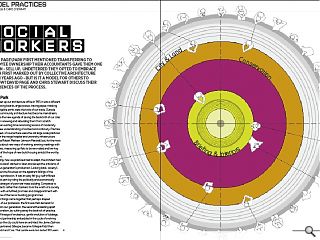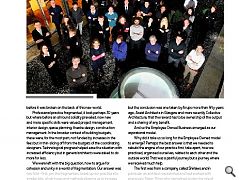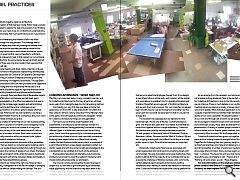Practice Management
15 Apr 2014
When Page\Park first mentioned transferring to employee ownership their accountants gave them one option - sell up. Undeterred they opted to embrace a path first marked out by collective architecture seven years ago - but is it a model for others to follow? David Page and Chris Stewart discuss their experiences of the process.
Page / ParkWhen we set up our architecture office in 1981, it was a different world. Drawing boards, angle-poises, tracing paper, masking tape and dyeline prints were the tools of our trade. Outside the office, community architecture had become mainstream, adapting to the new agenda of saving the backcloth of our cites rather than renewing and rebuilding them from scratch.
It was an exciting time reconciling lessons of modernity with this new understanding of context and continuity. Practice had changed, of course there were the old large scale practices carrying on the mega hospital and university infrastructure projects like Robert Mathew Johnson Marshall, but, for the most part, it was about new ways of working, evening meetings with communities, measuring up flats to be renovated and low key ambitions of the hope of new build housing amidst the worthy restorations.
For many, how we practiced had to adapt, the architect had become less aloof, started to listen and accept the criticisms of the previous generation’s production. Looking back, society’s angst at the time focussed on the apparent failings of the architecture profession. It was an easy fall guy, self-inflicted for the most part by riding the politically and economically driven bandwagon of post-war mass building. Compared to now, architects rather than bankers took the wrath of a society struggling with unfulfilled promises and disappointment with the outcome of the heroic building programmes.
So two things came together that perhaps shaped the nature of our profession, the first was that demand for humility from our generation, the second the blasting apart of professionalism, by cutting away the bedrock of practice. The idea of lineage of endeavour, gentle evolution of tutelege, practice and partnership embedded in the cycle of evolving practices, so the city could have an architect like James Salmon, who then partnered Gillespie, became Gillespie Kidd then Gillespie Kidd and Coia. That gentle evolution lasted 100 years before it was broken on the back of this new world.
Professional practice fragmented, it took perhaps 30 years but where before an all round solidity prevailed, now new and more specific skills were valued; project management, interior design, space planning, theatre design, construction management. In the broader context of building budgets, these were, for the most part, not funded by increases in the fees but in thin-slicing off from the budgets of the coordinating designers. Technological progress helped ease the situation with increased efficiency but in general architects were asked to do more for less.
We were left with the big question, how to argue for cohesion and unity in a world of fragmentation. Our answer was two fold - first, join the fragmenters, break up our practice into smaller bits, of job types and methods allowing us to increase our expertise in these areas but crucially in parallel create strategies to re-cohere these fragments into the unified whole we call architecture. The result being individual pockets of in depth knowledge but bound together with a common ambition of unified expression.
At the scale of the individual, the sense of responsibility changed. The individual was responsible for the development and articulation of a piece of the jigsaw for which there was no additional payment. Expecting that responsibility to be accepted without reward became untenable. How do we ask our architects and support to do more for less? It took us a long time but the conclusion was one taken by Arups more than fifty years ago, Assist Architects in Glasgow and more recently Collective Architecture, that the reward has to be ownership of the output and a sharing of any benefit.
And so the Employee Owned Business emerged as our aspirational model.
Why did it take us so long for the Employee Owned model to emerge? Perhaps the best answer is that we needed to rebuild the engine of our practice first, take apart, how we practiced, organised ourselves, related to each other and the outside world. That was a painful journey but a journey where we received much help.
The first was from a company called Shirlaws and in particular an architect we admired and had worked with previously, Robin Thíng who had retired to play the role of business coach in that company. It was some journey, two years of regular meetings of about fifteen to twenty of us where we discovered whilst we knew how to be architects, we had no idea of running a business beyond intuition. Robin didn’t give us the answer, he introduced the technical aspects of business, the relationships between the parts and the tools, which could be used to interconnect these parts.
Indirectly Robin gave us the means by which we could break down our business into the fragments. We called them Centres of Gravity (CoG) because the word implied the interdependence of each of these parts. We needed a way to break it down but also put it all back together again as architecture.
In the creation of that business model, Robin made us aware that we needed to explore the idea of succession in our thinking. Knowing how you mean to go on is critical to an understanding of what works today. Not much point having a car if you have no destination.
The idea of rewarding the initiative of all in the office emerged through this long process. The challenge was to find a way of legally and financially making the transfer from the traditional and now obsolete partnership model to this new ownership structure in a world where the historic model of investing in a partnership, was not feasible for architects struggling to make ends meet. In that respect our conventional support at the time; the accountants, lawyers and bank did not understand. There was only one model in their eyes and that was to sell, sell, sell.
A fortunate meeting with Brian Veitch, chairman of Arups Scotland and friend of the practice, helped things fall into place. He is an ambassador for Collective Co+Operative Development Scotland, a wing of Scottish Enterprise promoting home and employee ownership of indigenous businesses. Through Brian we were introduced to Glen Dott who provided some supportive business funding and most importantly introduced us to a parallel universe of business support, legal and financial advice for those wanting to explore the employee owned business model. Key amongst these was Ewan Hall of Baxendale, experts in this sort of transition and because we had spent years devolving responsibility in the office he enabled us in a year to pass through the complex legal, taxation and administrative hurdles to become last December, employee owned.
So, three months in it is still too early to assess what has been achieved. What we can say with certainty is we have a renewed determination to arrive at a consensus about our vision of a reassembled architectural praxis.
We have created a mental map of our new business setting, at its simplest it is a series of concentric and overlapping round tables. Everybody sits around the outside of our big table and are free to join any of the inner tables like arts & culture, technologies, or business activities. Each table is distinct but being generally concentric within our abstract solar system there is an implicit overlap and influence.
If the round tables are about discussion of the generalities of practice, then we depict our actual projects, buildings, plans and studies, as wedge shaped workbenches cutting through our circular model in the manner of spokes of our wheel. The beauty of this mental work-bench is that, whilst focused on a particular project, it intersects with all the discussion tables and thereby is influenced by these lateral thinking groups.
Time will tell if our model is the right one. However like a good building, if designed well it will flex and adapt to changing circumstance without compromising the concept. That is to bring architecture back together, built on the understanding of the parts as a representation of all who contribute.
Collective Architecture - Seven Years On
May Day is an important date in many a socialist calendar, and for Collective Architecture this first day of summer will mark seven years from making the leap to a formal working method.
Coincidently our very first step was taken a further ten years back, on 01.05.1997, a date shared with Tony Blair and New Labour’s famous victory. Since then Prime Ministers have come, gone, and will hopefully continue to disappear - whilst for Collective Architecture things can only get better.
Formed to pursue themes of participation and sustainability in architecture, we have always worked in a collaborative manner. Having personally functioned in many different types of architectural machine over the last thirty years, I have found the opportunity for individual expression and authorship of idea to be our most important possessions. Ensuring these opportunities are offered to all naturally creates the ideal business model where clients are assured of a committed architect; unique design develops to reflect our clients’ needs; and with the correct credit acknowledged to the individual all can be satisfied and much can be achieved.
We are passionate about an alternative way to practice architecture and wish to avoid the wellworn master/servant model continually endured by our profession.
The move to communal ownership should have been a simple one, our aim was to give everyone equal ownership, equal opportunity and the chance to help each other in our common goal. Capital gains tax and the endless bewilderment of lawyers, accountants and bank managers became obstacles that led us to adopt the Employee Owned Trust. It is a delight to see others follow a similar path, each solution will be special and good advice is available from Co-operative Development Scotland. Page\Park are a huge part of Scottish architecture, and we wish them every success. Our own route has not always been smooth, we are over our honeymoon and dare I say the seven year itch, but what we have learnt is that it is crucial not to keep still.
The recession has dug deep but our aspirations have remained high. We are one of the few Scottish practices to grow over the last few years and it is a matter of pride that we have stuck together without a single redundancy. Collective Architecture are currently working extensively across the UK with projects in Newcastle, Solihull Whitehaven, Preston, Aberdeen, Lothian, Stranraer and the West of Scotland. We are also enjoying working with the brilliant Martin Boyce on a new public square in Lyon. Diversification has been an important aim.
Historically Collective Architecture are associated with urban regeneration and continue to love working closely with communities, Housing Associations and Local Authorities. Now public buildings form the majority of our workload and we are enjoying the challenge of libraries, business units, community centres, galleries, sports projects, artist studios, lighting Installations and a variety of creative interventions to name but a few. Collective Architecture has become a sturdy platform for all our wonderfully talented and (in the main) young individuals, working as a whole to progress as one.
As we emerge from the recession, our hard work and camaraderie will pay dividends. Now is the perfect opportunity for Collective Architecture to look to the future and see how we can improve. There is much debate in our lunchtime office meetings where we discuss a variety of issues ranging from resource to quality. While individual expression is important, it is equally important that we maintain high standards and the quality of our work is essential. We all participate in reviews of all our work and through self criticism we self police. Individuals are encouraged to research issues which are relevant to their work and wider society, these ideas are shared through short presentations. A variety of smaller groups consider important office business such as finance, public relations, bids and importantly office structure. We shall shape what is to come.
Collective Architecture have grown up together, shared the pains and are looking forward to a bright future. We applaud Page\Park for following their own journey, delight in the young architectural practices who make kind reference to our practice and string together a number of well known quotations to encourage others to follow: ‘Every journey begins with the first step’ - Confucius. ‘You never fail until you stop trying’ - Einstein. ‘Everything you can imagine is real’ - Picasso and of course ‘Nothing will work unless you do’ - Maya Angelou.
For more information on the employee owned trust please contact Sarah Deas at Co-operative Development Scotland, via their helpline 0141 951-3055
|
|
Read next: Derelict Glasgow
Read previous: Glasgow School of Art
Back to April 2014
Browse Features Archive
Search
News
For more news from the industry visit our News section.
Features & Reports
For more information from the industry visit our Features & Reports section.





